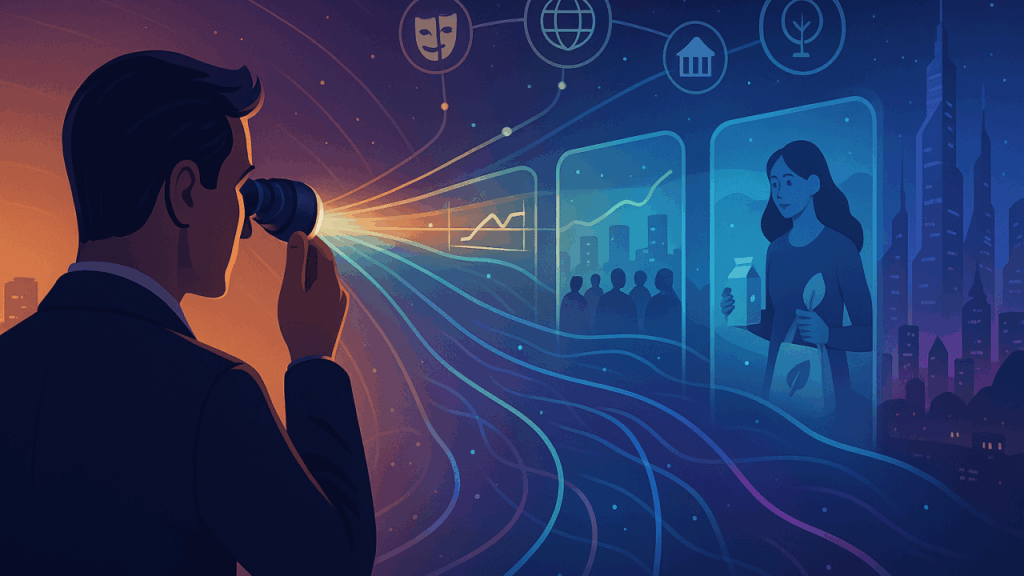
By Ravi VS
We live in an age where customer preferences shift faster than quarterly reports can capture.
Yet most organisations still rely on historical data and lagging indicators to make strategic decisions — an increasingly inadequate method.
Why don’t we focus on Foresight? It’s the ability to anticipate emerging needs before they are obvious. And now Foresight has moved from the realm of futurists into the toolkit of high-performing businesses. It’s not about guessing the future. It’s about applying structured, science-based methods to detect weak signals today that will become market-shaping forces tomorrow.
The Data Behind the Shift
- 98% of leading firms now integrate foresight into their customer strategy (source: Global Strategic Foresight Survey, 2025).
- 85% report that foresight is most valuable in ambiguous or volatile contexts, where traditional market research fails to provide actionable clarity.
- McKinsey research shows that companies using predictive insight outperform peers by 33% in revenue growth during periods of uncertainty.
- Behavioural science studies (Kahneman & Tversky, 1979; Gigerenzer, 2008) reveal that humans are wired for recency bias, overweighting the present and underestimating long-term change — a cognitive blind spot that foresight tools are designed to overcome.
Why Traditional Research Falls Short
Customer surveys and focus groups capture what customers say. Foresight, however, reveals what customers will value — often before they can articulate it themselves.
Example: In 2015, most smartphone users couldn’t imagine needing face recognition for payment authentication. By 2020, driven by security concerns and pandemic-induced contactless norms, facial biometrics had become mainstream. Traditional research alone would have missed this inflexion point; foresight methods would have picked up the weak signals years earlier.
Behavioural Forecasting – applying cognitive science to predict shifts in preferences and decision patterns.
Neurological studies using fMRI (Mullally & Maguire, 2013) show that the brain uses the same neural networks for remembering the past as for imagining the future. Foresight isn’t just a corporate skill — it’s a human evolutionary advantage we’ve neglected in business strategy.
The Science of Anticipation
Foresight blends multiple disciplines:
Signal Intelligence – spotting early indicators in technology, culture, and policy before they converge into trends. Scenario Planning – constructing plausible futures to stress-test decisions. Systems Thinking – mapping how changes in one domain (e.g., regulation) cascade into others (e.g., consumer trust).
Why This Matters for Customer Understanding
Customers live in futures, not in your spreadsheets — by the time data confirms a shift, leaders are already behind. Markets are shaped by forces outside your industry — foresight scans adjacent domains to reveal hidden drivers of demand.
Trust is built by anticipation — when customers see you meeting their needs before they arise, loyalty deepens.
A Case in Point: One global outdoor apparel company used foresight scanning to detect early signals of extreme-weather lifestyle adaptation in urban Asia. While competitors focused on seasonal product cycles, they introduced a line of “urban climate gear” — water-repellent, heat-adaptive fabrics — two years before the first climate-related urban flooding crises hit. That product line became their fastest-growing category, driven not by luck but by systematic anticipation
The Takeaway
Foresight is not about predicting the future with perfect accuracy. It is about understanding customers in motion, seeing them in the context of unfolding change, and positioning your organisation to serve needs that are not yet visible to the naked eye.
In a market where speed of relevance is more important than speed to market, foresight may be the single most critical skill your leadership team can master.
WE